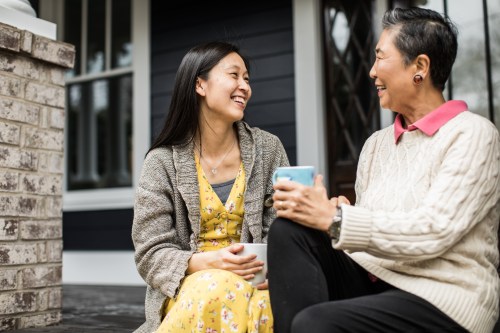How To Navigate Multilingual COVID-19 Conversations
Language barriers are tough. Here, experts provide tips on navigating multilingual conversations about COVID-19.

A few weeks ago, my po po (grandmother in Cantonese) and I jumped on a phone call for our weekly check-in. The call went well until she asked me: “Should I get the COVID-19 vaccine and where can I get it?” As a first-generation Chinese-American, I was fumbling on how to explain mRNA and how it works in Cantonese, my po po’s native language. So, I opted for a simile, using security guards as an attempt to describe how the COVID-19 vaccines work. I failed miserably. Navigating multilingual conversations about COVID-19 with older family members is no easy task.
Experts in This Article
a board-certified family medicine physician and District Medical Director at One Medical in North Carolina
Frida L Perales Blum, JD, MA is a certified linguist for Hanna Interpreting Services
Before changing my approach, I had to ask myself: What are the communication barriers? Alexa Mieses Malchuk, MD, MPH, a multiethnic family physician in North Carolina, says there are three main considerations.
First, not everyone will have a medical background and might not know how to explain mRNA, so Dr. Mieses Malchuk recommends keeping health literacy in mind.
The second challenge is internet literacy. “Major healthcare systems are communicating with their patients about vaccine availability via an electronic medical record. Folks from a different generation, regardless of what language they speak, may not be technologically savvy. If you don’t know how to use those things, it really is challenging,” says Dr. Mieses Malchuk.
Lastly, language can also be a barrier. (In my experience, it can feel like rock climbing without any equipment.) “These barriers become more tangible among older people because they might not be able to learn the language,” says Frida L. Perales Blum, JD, MA, a certified linguist for Hanna Interpreting Services, based in California.
Dr. Mieses Malchuk and Blum offer some tips on how you can improve your lingo and better navigate multilingual conversations about COVID-19 with your loved ones.
Tips for multilingual conversations about COVID-19
1. Use plain language
“Sometimes the information is conveyed in terms that are not easily understandable to the targeted audience or to a layman because it contains heavy medical or technical terminology,” says Blum. Blum and Dr. Mieses Malchuk recommend using plain language when explaining medical terminology surrounding the COVID-19 vaccine.
“I love the example about using words like ‘soldiers’ because if we can explain in a way that makes sense to them, then I’ve done my job in terms of being an effective communicator,” says Dr. Mieses Malchuk. So instead of using mRNA, try soldiers or security guards when explaining how the COVID-19 vaccine works.
2. Utilize an interpreter instead of translating apps
It can be tempting to use a language translation app when you can’t explain the COVID-19 vaccine in your loved ones’ native language. However, Dr. Mieses Malchuk recommends steering clear. “There’s a difference between interpretation and translation. Translation is when you take one word from one language and literally translate it into another language. But it doesn’t take into account some of the nuance meanings that come out in conversation.”
Instead of relying on apps, first begin by speaking about your health with a loved one or friend. They can hopefully help you find an available health-care professional who can provide formal medical advice. Dr. Mieses Malchuk suggests asking a physician who does speak the language, or requesting an interpreter to explain COVID-19 information. Upon request, interpreter services are available at hospitals and clinics. Such services are protected under the Health Insurance Portability and Accountability Act (HIPAA), ensuring that all of your information remains private, according to Dr. Mieses Malchuk.
3. Turn to community organizations for information
If you’re struggling to explain what the COVID-19 vaccine is and where your loved ones can sign up for it, Blum suggests looking to trusted organizations and leaders in the community. “These trusted messengers could be religious leaders, medical practitioners, teachers, and these trusted messengers can play a crucial role in the communication process,” says Blum.
Dr. Mieses Malchuk says that local government and health departments are another great option as they have the latest COVID-19 information available in other languages. Dr. Mieses Malchuk recommends the CDC and familydoctor.org. “Those sites have a plethora of information on COVID-19, the COVID-19 vaccine, as well as other health issues,” says Dr. Mieses Malchuk.
4. Practice patience with older family members about the internet
I am guilty of not always practicing patience when showing my po po how to use the internet. But patience is key in helping older folks navigate the web. Dr. Mieses Malchuk recommends sitting down with your loved ones to show them the online resources and taking things step by step. “It’s important to be patient and understand where the other person is coming from. I’ve gone as far as spending a visit with a patient showing them a website and reviewing information with them,” she says. With some effort, these conversations don’t have to be daunting.
Listen to a biochemist explain how vaccines work:
Have you checked out The Well+Good SHOP? Our editors sift through hundreds of products every week so that you don’t have to—and now, you can find their faves (from skin care to self care and beyond) in one carefully curated space. What’re you waiting for? Get shopping!
Sign Up for Our Daily Newsletter
Get all the latest in wellness, trends, food, fitness, beauty, and more delivered right to your inbox.
Got it, you've been added to our email list.










